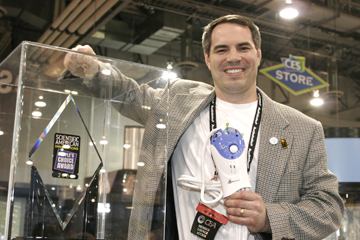
Hello, my name is Christopher Hawker. I am a professional inventor, specializing in innovative consumer products. My company is called Trident Design, LLC. I have developed many products in numerous industries and have over 20 products on the market. My most famous invention is the PowerSquid, a cephalopod-inspired power strip with outlets situated at the end of short cords, thereby eliminating the problem of losing outlets to bulky transformer plugs. John Biggs, editor-in-chief of this blog, has asked me to write the story of the birth of the PowerSquid and its development and journey to market. This is the Song of the PowerSquid.
Part 2: Development
With the PowerSquid concept in the house, we began our development process by researching the market, to see if a similar product was already out there. We did our own patent and internet searches and combed through mail-order catalogs and hardware stores. We ordered catalogs from manufacturers and searched them with baited breath. But nowhere did we find another PowerSquid. In fact, there were no interesting power strips on the market at all at that time. They were all just rectangular boxes with outlets.
We brainstormed for weeks about the form of the PowerSquid. We wanted to stand out on the shelf, so we determined our new product should be biomorphic, looking like an actual squid as opposed to something more traditional and square.
We experimented with how many cords there should be (we settled on five) and different configurations (we settled on a V-shape). We made foam models of the body and wired a working prototype with materials from a local hardware store. We explored ways to make the inner wiring easy to manufacture considering the number of conductors that needed to be spliced. We considered additional features. We wanted to add glowing outlets and different mounting attachments. One of the designers even came up with a whole new invention to serve as a bonus feature: the Ejector Plug, which utilized a small lever to assist in unplugging devices from cords.
While developing the PowerSquid, I began debating with my advisors how to best monetize the idea. We decided it was out of my league to manufacture the PowerSquid. It was high-voltage (110v), and thus would require Underwriter’s Laboratory certification to be sold in major retailers. This was an expensive process and beyond my knowledge and experience. We decided we needed to license the idea to a partner already in the industry, someone established, experienced and with resources. That required a patent. At the time I didn’t know anything about patents, so I interviewed local patent attorneys, finally settling on a firm that specialized in intellectual property (IP). I borrowed a few thousand dollars from my brother, Jon, and his wife, Lisa, to pay for the patent application. We also applied for a patent on the Ejector Plug, which we felt might have even more potential because it could be used on any device with a plug.
We weren’t getting enough fee contracts to cover overhead because the economy slowed due to 9/11 and the dot com crash, and I ran out of cash. I worked on a business plan, and then went looking for investors in Trident based on the PowerSquid and the Ejector Plug. I first approached friends and family and managed to raise enough money to keep the business afloat while I looked for more, eventually scoring with one of my father’s business associates. I had met him at a party and suspected he might be interested in investing, so I contacted him and made a pitch. He had me negotiate with his chief financial officer, a process that took several months, and eventually we struck a deal that required me to give up a significant share of my company, but which kept us alive to pursue the PowerSquid and Ejector Plug.
I formed Trident into a Limited Liability Company and, funded for the first time, I hired a business development professional and a full-time graphic designer. We set out to create professional brochures for the PowerSquid and Ejector Plug, and then went fishing for a licensee.
Christopher Hawker, an inventor specializing in innovative consumer products, is founder of Trident Design, LLC in Columbus, Ohio. He is the author of “Inventor’s Mind: 10 Steps to Making Money From your Inventions”, a free e-book available at Invent-Shop.com. He will be hosting his first InventShop Inventor’s Workshop in October 2009 for serious inventors who want to learn his inventing system.
This is part 2 of a 6 part series. Read them all here.
Want a PowerSquid? Leave a comment below (including your email) and we’ll pick one commenter at random per day. The winner of yesterday’s PowerSquid is Jason Nielubowicz.